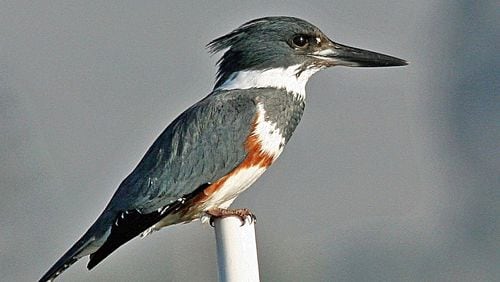I stopped at the Johns Homestead Park near Tucker last week to see what was stirring. Right off, I spotted a dark blue, medium-size bird perched on a low limb at the edge of Twin Brothers Lake, peering intently into the water.
The bird was a couple of hundred feet away, but I knew immediately that it was a belted kingfisher. Its distinctive profile — large head, short neck, stocky body, short tail, chisel-shaped bill and perky crest — made it easy to identify.
With the help of my binoculars, I also saw that it was a female because of the conspicuous rusty belt on the belly beneath a band of blue feathers across an otherwise white chest. Male kingfishers have no second belt. The belted kingfisher, in fact, is one of few bird species in which the female is more colorful than the male.
Usually found along lakes, rivers, streams, marshes and ponds, belted kingfishers are relatively common in Georgia. Their population increases this time of year when northern birds migrate south and join year-round residents for the winter. Except during the breeding season, they are mostly loners.
Often emitting a rough, raucous, rattle call, kingfishers perch on a low branch, dock or telephone wire and continuously scan the water for prey.
As if on cue, the bird I was watching suddenly plunged into the water and quickly came up with a small wriggling creature in its bill. It darted away, presumably to a tree to beat the prey to death and then swallow it head first.
Belted kingfishers, the only kingfisher species in the eastern United States, generally prey on fish that inhabit shallow water or swim near the surface, but they also may eat amphibians, reptiles, crustaceans and other small creatures.
Come spring, belted kingfishers exhibit a unique trait among Georgia birds: They excavate long tunnels into the sides of steep banks to nest.
IN THE SKY: From David Dundee, Tellus Science Museum astronomer: The moon will be new on Sunday. Brilliant Venus is very low in the southwest just after dark and sets about two hours later. Mars, also shining brightly, is in the southeast at dusk. Jupiter is in the southwest at dusk and will appear near the moon on Thursday night. Saturn is low in the southwest just after dark.






